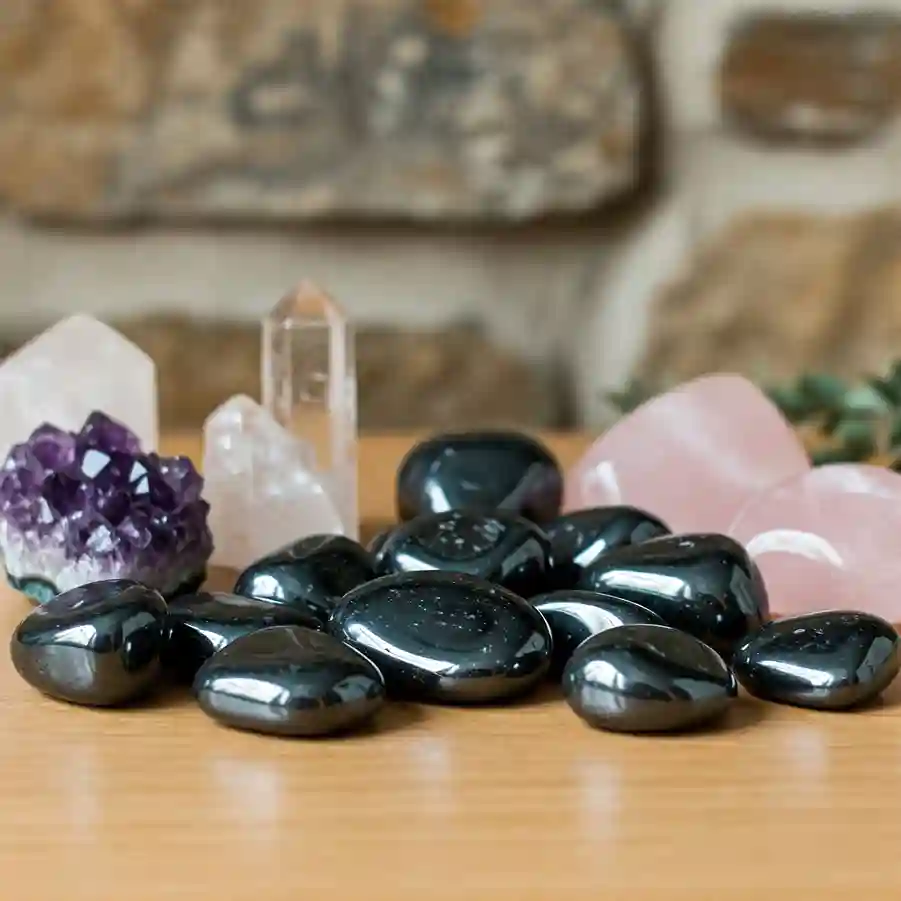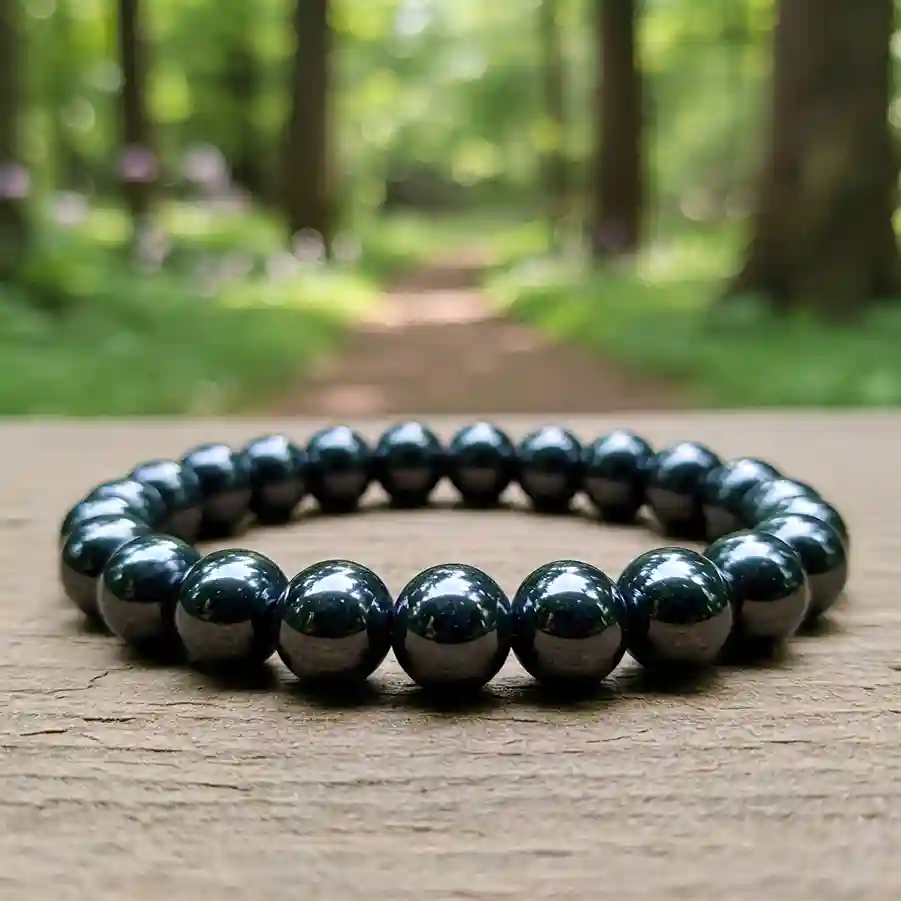Hematite looks cool. It’s shiny, heavy, and has this magnetic pull—literally and figuratively.
A lot of people wear it thinking it’ll help with anxiety, focus, or energy. And sometimes it does.
But here’s the thing no one really tells you: hematite doesn’t work the same for everyone. In fact, for some people, it causes more problems than it solves.
We’re talking stuff like headaches, weird mood swings, even dizziness. Some folks break out in rashes from the metal. Others say they just feel “off” when they wear it too long.
But because it’s marketed like some magical healing stone, most people don’t even think to connect the dots.
I wrote this blog because I think people deserve the full story—not just the shiny side.
So if you’ve been using hematite and something doesn’t feel right, or you’re just curious about the less talked-about side of it, keep reading.
This is what most people don’t tell you about hematite—and it might just explain a lot.
Also Read: The 11 Astonishing Benefits Of Wearing Hematite Bracelet
What Is Hematite?
Hematite is a natural mineral that contains a high amount of iron and is often used in jewelry, magnetic therapy, and spiritual practices.
It usually appears as a shiny, metallic-looking stone—black, gray, or sometimes with a reddish tint.
The red version happens because of the iron content, which oxidizes over time (like rust).
Hematite is believed to help with grounding energy, improving focus, and protecting against negative emotions.
It’s also used in alternative healing practices where people wear it as bracelets, rings, or pendants.
Some types of hematite are magnetic, and those are often used in bracelets that claim to improve circulation and reduce pain.
But not everyone reacts the same way to this stone—and some may even experience negative effects.
Also Read: Who Should Not Wear Peridot

15 Side Effects Of Hematite
Although many people believe hematite has healing powers, it can cause unwanted side effects, especially when worn for long periods or by people with sensitivity to energy, metals, or magnetic fields.
Below are the possible side effects explained in detail, with each one including what to look out for.
1. Skin Irritation
Some people develop redness, rashes, or itching after wearing hematite jewelry. This usually happens if you have sensitive skin or are allergic to metals.
The iron in hematite can react with sweat or body oils, especially in hot or humid weather, causing irritation.
In some cases, nickel may also be present in hematite-coated jewelry, which can make the reaction worse.
2. Headaches
Wearing hematite, especially near the neck or head, can sometimes lead to headaches.
This might happen due to sensitivity to magnetic fields or the weight of the stone putting pressure on the skin.
People who are prone to migraines or tension headaches may notice discomfort after wearing hematite necklaces or earrings.
3. Dizziness or Lightheadedness
Some users report feeling dizzy or unsteady while wearing hematite.
This could be due to energy sensitivity or the effect of magnets on the body’s natural electric signals.
If you experience lightheadedness that goes away after removing the stone, hematite may be the cause.
Also Read: Can I Sleep With My Evil Eye Bracelet On
4. Fatigue
Instead of feeling more energized, some people feel tired or mentally foggy after wearing hematite.
This can happen if the grounding effect of the stone becomes too strong.
Hematite is believed to “pull down” excess energy to help people stay calm—but for some, it might leave them feeling slow, heavy, or unmotivated.
5. Mood Swings
Wearing hematite can sometimes trigger emotional ups and downs.
Some people say it brings hidden emotions to the surface, which can feel intense.
If you notice sudden shifts in mood while wearing hematite, it could be your body’s emotional response to the stone’s energy.
6. Tingling or Numbness
You might feel tingling or even numbness around the area where the hematite touches your skin.
This is more common with magnetic hematite bracelets. If worn too tightly, they can reduce blood flow or affect nearby nerves, especially in the wrist.
7. Sleep Problems
Wearing hematite at night can disturb your sleep or lead to strange dreams. While some people find it calming, others feel restless or have trouble sleeping.
Its grounding nature might interfere with your natural sleep rhythm, especially if worn too close to the head.
8. Heart Palpitations
Rarely, people who are sensitive to magnets may experience changes in their heartbeat.
Magnetic hematite, when worn near the chest, might cause mild irregularities in heart rhythm, especially for those with heart issues or implanted medical devices.
Also Read: Side Effects Of Blue Eye Bracelet
9. Heavy Feeling In The Body
Some people describe a sense of heaviness or being “pulled down” after wearing hematite for a long time.
This may be due to hematite’s grounding energy, which is meant to bring balance—but for some, it feels more like being weighed down physically or mentally.
10. Metallic Taste Or Smell
A metallic smell on your skin or a taste in your mouth can occur after wearing hematite.
This can happen if the iron reacts with your sweat, especially in hot weather or during exercise. It’s harmless in most cases but may feel unpleasant.
11. Nausea
A few people report feeling nauseous when wearing hematite.
This is rare, but it can happen if you’re very sensitive to magnetic fields or subtle energy shifts. Removing the jewelry usually helps the feeling go away.
12. Restlessness or Overstimulation
Not everyone finds hematite calming—some feel jittery or overly alert.
This can happen if the stone activates certain energy centers in the body too strongly. If you feel anxious or wired while wearing it, that’s a sign it may not be right for you.
Also Read: Who Should Not Wear Jade
13. Interference with Medical Devices
Magnetic hematite can interfere with pacemakers, insulin pumps, or other medical electronics.
If you wear such a device, avoid magnetic jewelry entirely, as it may disrupt the signals or performance of your equipment.
14. Breakouts or Acne
Wearing hematite close to your skin for long periods may cause pimples or clogged pores.
This usually happens when the jewelry traps sweat and dirt against the skin, especially on the neck or wrist. Keeping the area clean can help reduce this effect.
15. Allergic Reaction to Iron or Coatings
Some hematite jewelry is coated with metals or chemicals that can trigger an allergic reaction.
Symptoms include itching, swelling, or burning where the jewelry touches your skin. Always check if the piece is coated or mixed with other materials before wearing it.
Also Read: Spiritual Meaning of Earrings Falling Out

Who Should Avoid Hematite?
While hematite is safe for most people, there are certain individuals who should be more cautious or completely avoid wearing it.
Here are the groups of people who may need to stay away from hematite or use it only under supervision:
- People with pacemakers or implanted medical devices: Magnetic hematite can interfere with devices like pacemakers or insulin pumps. It may disturb how they work, which can be dangerous.
- People who are sensitive to metals: If you’ve had allergic reactions to jewelry in the past—like rashes, itching, or burning—hematite might cause the same problems, especially if it’s mixed with nickel or other metals.
- People with epilepsy or seizure disorders: In rare cases, strong magnetic fields (from magnetic hematite) may affect the nervous system. It’s better to be cautious if you have conditions like epilepsy.
- Pregnant women (especially in early stages): There’s no solid proof that hematite is harmful during pregnancy, but due to hormonal changes and increased sensitivity, it’s better to avoid magnetic versions unless your doctor approves.
- Children under 5 years old: Small hematite pieces can be a choking hazard. Plus, children are more sensitive to energy and metal exposure, so it’s better to avoid using it on them directly.
- People with iron sensitivity or iron overload conditions (like hemochromatosis): Even though wearing hematite doesn’t usually affect your body’s iron levels, some people with iron-related conditions prefer not to risk extra exposure through the skin.
- People who experience dizziness, headaches, or mood changes while wearing it: If you feel strange or uncomfortable with hematite, it’s a sign your body doesn’t respond well to it. Listen to that feeling and remove it.
Also Read: Side Effects Of Selenite
How To Minimize Side Effects Of Hematite?
If you still want to wear hematite but want to avoid side effects, there are easy steps you can take to make it safer and more comfortable to use.
Here are simple ways to reduce the risk of any problems while wearing hematite:
- Wear it for short periods at first: Start with just a few minutes or an hour a day to see how your body reacts before wearing it all day long.
- Avoid sleeping with hematite on your body: Remove bracelets, rings, or necklaces before going to bed. It gives your body a rest and prevents sleep-related side effects like restlessness or strange dreams.
- Keep it away from your chest if you have heart issues or devices: Avoid wearing magnetic hematite near your heart if you use medical equipment like pacemakers, or if you are sensitive to magnetic fields.
- Clean your jewelry often: Hematite can collect sweat and oil, which may irritate your skin. Clean it gently with a soft cloth to keep it safe and hygienic.
- Don’t wear it too tightly: Make sure hematite bracelets or rings aren’t pressing too hard on your skin. Tight jewelry can block blood flow and cause numbness or tingling.
- Watch for skin changes or reactions: If you notice redness, itching, or any rash, remove the jewelry right away and give your skin a break.
- Use non-magnetic hematite if you’re sensitive: Magnetic hematite is stronger in energy and more likely to cause side effects. Non-magnetic versions are gentler and better for sensitive people.
- Take breaks during the day: You don’t need to wear hematite all the time. Taking it off for a few hours can help your body stay balanced.
- Avoid wearing hematite during workouts or in hot weather: Sweat can mix with metal and irritate your skin. It can also speed up the reaction between hematite and your body.
- Store it safely when not in use: Keep your hematite jewelry in a dry, clean place to prevent damage or buildup of bacteria that could affect your skin.
Also Read: Side Effects Of Citrine

Final Thoughts
Hematite is a powerful and popular stone, often worn for its grounding, balancing, and calming energy.
But just like anything else that affects your body or energy, it’s not for everyone.
Some people may experience mild to moderate side effects, especially if they’re sensitive to metals, magnets, or shifts in energy.
The good news is that most of these effects can be avoided or reduced by using hematite the right way—wearing it for short periods, keeping it clean, and paying attention to how your body feels.
If something doesn’t feel right, it’s okay to take a break or try a different kind of stone that suits you better.
Everyone’s experience with hematite is different, and what works for one person might not work for another.
The key is to stay aware and use it with care. Listen to your body—it always knows best.
